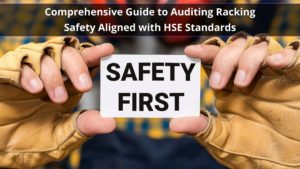
I’ve written a lot about racking inspections over the past couple years, but I’ve still got a lot more to say!
If I had wanted to write a book about racking inspections, I could have. Between providing insight for The Telegraph, EHS Today, e27 and countless other national and international publications, I have written a lot about racking inspections and workplace safety. Add all that to the writing I’ve done for this blog and that’s over 100,000 words.
Pride and Prejudice, Harry Potter and The Philosopher’s Stone and Paper Towns: all of those books are less than 100,000 words. So when I say “I could have written a book”, I mean it.
I write because it helps to inform past customers (and potential future customers) about what my work is and why it’s important. In the most basic sense, I do it because it helps to build relationships. I’m not alone in thinking this and many business leaders have long extolled the benefits of writing for their company.
So at this particular milestone, I think it would be good to reflect on what I’ve learned after writing 100,000 words on racking inspections.
1. Racking Inspections Are Important
Some people might say that their industry is too niche to write about, but that’s rarely true. There is a reason that you sell your product or service. There is a reason that your product or service is important.
For me, the reason is simple: every business with a warehouse or a storage system needs regular racking inspections. That’s not just my opinion; it’s the opinion of HSE, the EU and the SEMA Racking Code of Practice as well. Without inspections, warehouses safety goes unchecked and — unfortunately — that’s often when tragedy happens.
Not all workplace accidents are the result of a lack of racking inspections. However, by combining racking safety with other forms of workplace safety, HSE and small businesses like SEE have helped to contribute to an 85% reduction in workplace fatality and a 77% reduction in workplace injury since 1974. There’s still a lot more work to be done, but it’s good to look at the historical picture every now and again and consider how far we’ve come.
2. The Future of Racking Inspections
It’s hard to predict the future. Even after writing over 100,000 words on racking inspections, I still couldn’t say for sure what the industry will look like in 10 or 20 years time. However, that doesn’t mean that I’m not willing to speculate.
The biggest challenge to health and safety’s future is lack of government spending. In the UK, HSE budget cuts (which started in 2010 and are set to continue well into the future) have forced the industry to innovate. Whether or not you agree with these cuts is beside the point. The fact is that they are happening and that the industry needs to react.
Not all of this reaction has been met with praise. Some have criticised HSE’s increasing focus on fines in order to raise money. It’s a bold step, but it might be the best one in the long-term.
Other approaches have had a much more positive response. When HSE introduced the new CDM Regulations in 2015, some praised the changes and even linked them with a huge confidence boost for British builders.
In short, the new CDM regulations claimed that a “client” was anyone in charge of almost anything that could be considered a construction site. This new definition included warehouses, film sets and even temporary structures for events.
What’s more, it is now the client’s responsibility, not the government’s, to ensure the safety of their construction site by being the final arbiter of what is safe and what is not. Should the client need to defend their definitions of “safe” or “technically competent” in a court of law, they will need to refer to existing legislation. However, the CDM regulations mean that it is no longer the government’s job to keep tabs on the safety of projects.
By making the responsibility and definition of the “client” clearer, the new regulations mean racking inspections by SEMA approved inspectors are more important than ever. Without the government to step in and make sure that sites are safe, businesses further realised the importance of HSE’s recommendation that they need a racking inspection from a SEMA approved racking inspector at least once a year.
3. Dispelling Health & Safety Myths Is Vital
Despite the tremendous progress that HSE and the health and safety industry has made in making sure the UK has the second lowest workplace fatality rate in the EU, many are still willing to mock HSE’s efforts. They do so by spreading stories about “health and safety gone mad”. Most of these stories are either complete myths or have nothing to do with HSE whatsoever. However, by the time HSE bust these myths, the damage to its reputation has already been done.
By writing about the important work that workplace safety and racking inspections can do for businesses, my aim is to put the work that the health and safety industry does in a positive light. We should be proud that the UK is a safe country; I know I am.
For racking inspection training and racking inspections from a SEMA approved racking inspector and passionate writer on the topic of health and safety, contact Storage Equipment Experts today!





